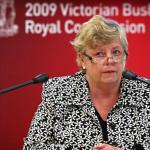
Saturday February 7th 2009 was a day of severe weather in Victoria. The Bureau of Meteorology recorded a maximum temperature of 46.4 degrees Celsius (the hottest temperature recorded in any Australian capital city), hot northerly winds of up to 100 kilometres per hour and virtually no humidity. These conditions combined to create the worst bushfire risk in the history of the state, exceeding those of ‘Black Friday’ (1939) and Ash Wednesday (1983). The conditions prompted Victorian premier John Brumby to predict “the worst day… in our history”.
These warnings proved accurate. In a 24 hour period from February 7th more than 400 separate fires were recorded, started by lightning strikes, downed power lines and arsonists. In the extreme heat, high winds and tinder dry conditions, these fires became uncontrollable and frightening in their size, speed and heat. Six major fire complexes were reported, the largest around Kinglake, north-east of Melbourne. This particular fire destroyed the townships of Kinglake, Marysville, Strathewen, Flowerdale and Toolangi. Across Victoria bushfires killed 173 people and injured more than 400. More than one million acres were burnt and around 3,500 buildings destroyed, with property losses estimated at more than $1 billion. It was the worst natural disaster in Victoria’s history.
Given its magnitude, it was inevitable that questions would be asked about the government’s handling of the situation and whether existing laws and procedures were adequate and appropriate for such extreme bushfire conditions. Within two days, Premier John Brumby had announced a Royal Commission into the 2009 bushfires and the state’s preparation and response. The terms of reference given to the Royal Commission were extremely broad, Brumby describing it as the “most open inquiry that is possible. No stone unturned. Every bit of information on the table. And if that means calling ministers or premiers, or whoever it is, we will be happy to assist.” The terms of reference called for investigation into:
- “The causes and circumstances of the bushfires…”
- “The preparation and planning by governments, emergency services, other entities, the community and households for bushfires in Victoria, including current laws, policies, practices, resources and strategies…”
- “All aspects of the response to the 2009 bushfires, particularly measures taken to control the spread of the fires and measures taken to protect life and private and public property…”
- “The measures taken to prevent or minimise disruption to the supply of essential services such as water and power during the 2009 bushfires…”
As explained by the Premier, there were few restrictions on the Commission’s power of investigation, the terms of reference declaring that “we [the monarch] give and grant you full power and authority to call before you such person or persons as you shall judge likely to afford you any information upon the subject of this Our Commission, and to inquire of and concerning the premises by all other lawful ways and means whatsoever.” The terms of reference also called for an interim report, to be provided no later than August 17th, 2009, so that any recommendations could be implemented for the 2009/10 bushfire season. The Commission’s first step was to issue practice notes to clarify its operation and proceedings.
In its first six months the Royal Commission received more than 1,260 submissions, conducted more than four weeks of public consultation and eight weeks of public hearings, in which it heard from 87 witnesses. Its August 2009 interim report made 51 separate recommendations, among them reform and improvements to bushfire warning systems. There was also much attention on the government’s controversial ‘stay or go’ policy, leaving individual homeowners to decide whether to remain with their homes if a bushfire approaches. According to one source:
Testimony during the first two and half weeks of the Victorian royal commission investigation into the February 7 bushfires has revealed that the tragically high death toll was caused by grossly inadequate emergency services, lack of fire warnings and the absence of any centralised evacuation plan… Several fire survivors, including one who lost his entire family, have presented damning testimony about blocked roads and non-existent warnings and fire shelters. Their experiences constitute a devastating exposure of the state’s ‘stay or go’ policy.
Some of the Commission’s recommendations, such as the development of a new early warning system that utilises all radio and television channels as well as mobile phone networks, were rushed into existence by the government. Others are currently being considered. On November 24th 2009 the Royal Commission published a second interim report, making seven recommendations on construction and building practices in bushfire-prone regions. The Commission handed down its final report in July 2010. This report contained detailed criticisms and recommendations about a range of bushfire-related issues.
© lawgovpol.com 2014. Content on this page may not be republished or distributed without permission. For more information please refer to our Terms of Use.
